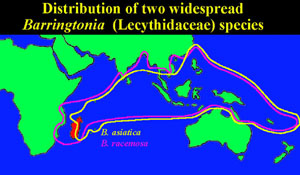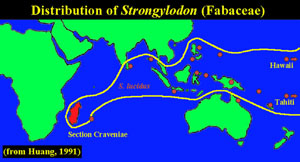 |
QUICK SEARCH
MO PROJECTS:
Africa
Asia/Pacific
Mesoamerica
North America
South America
General Taxonomy
Photo Essays
Training in Latin
America
MO RESEARCH:
Wm. L. Brown Center
Bryology
GIS
Graduate Studies
Research Experiences
for Undergraduates
Imaging Lab
Library
MBG Press
Publications
Climate Change
Catalog Fossil Plants
MO DATABASES:
W³MOST
Image Index
Rare Books
Angiosperm
Phylogeny
Res Botanica
All Databases
INFORMATION:
What's New?
People at MO
Visitor's Guide
Herbarium
Jobs & Fellowships
Symposium
Research Links
Site Map
Search
Malagasy/Indo-australo-malesian Phytogeographic ConnectionsLong Distance Dispersal | Conclusion | References LONG DISTANCE DISPERSAL (LDD)
The difference between stepping-stone dispersal and long distance dispersal (LDD) is only a matter of distance, which is just one of the factors contributing to probability of dispersal; the former might also be described as short to medium distance dispersal. Any dispersal across a fragmented space is rendered more probable when a taxon possesses an added degree of vagility (small, resistant, aerodynamic, or buoyant disseminules), and/or time. That dispersal over especially long distances has occurred is undeniably proven by the many Asian taxa that have reached the Hawaiian Islands in recent history, a distance of 8,000 km. As Raven (1979) noted, the distance from Australia to Madagascar is only about 2/3 (5,400 km) of that from Asia to Hawaii, and both source and target have existed for an extremely long time. Prevailing easterly winds and ocean currents in the Indian Ocean further increase the probability for LDD from Malesia to the western Indian Ocean (Renvoise 1979). Accepting the fact that LDD is potentially continuously occurring, implies that it has undoubtedly occurred recently, as is witnessed by dispersal to the young volcanic Mascarenes (e.g., a phyllodic Acacia of certain Australian affinity (Bell & Evans 1978, who nevertheless conclude a former land connection between Australia and Mauritius)). Despite extrinsic directional forces, LDD is often stochastic in nature, and more often that not results in a highly imbalanced distribution.
Additional examples of imbalanced distributions include: Gluta (Anacardiaceae) - 1 sp. Madagascar, 28 spp. Malesia; Hibbertia (Dilleniaceae) - 1 (variable) sp. Madagascar, > 100 spp. Malesia, centered in Australia; Keraudrenia (Sterculiaceae) - 1 sp. Madagascar, 8 spp. Australia.
|
© 1995-2025 Missouri Botanical Garden, All Rights Reserved
4344 Shaw Blvd.
St. Louis, MO 63110
(314) 577-5100
Technical Support



